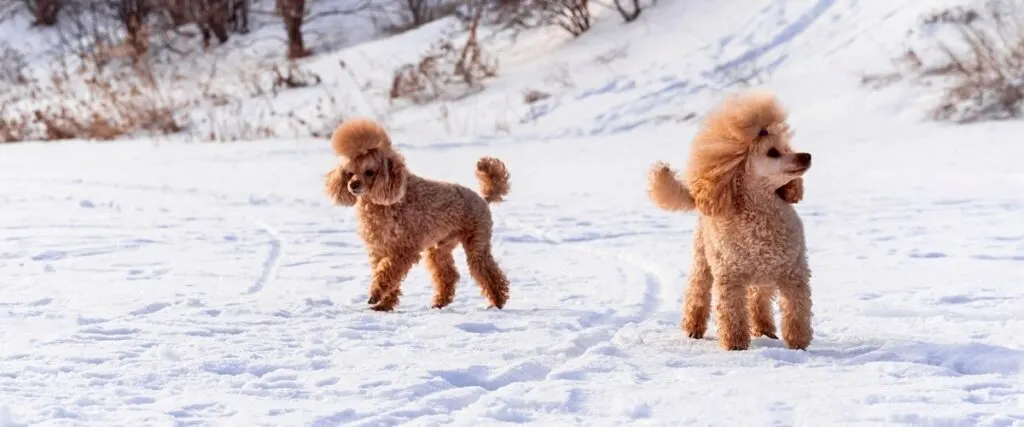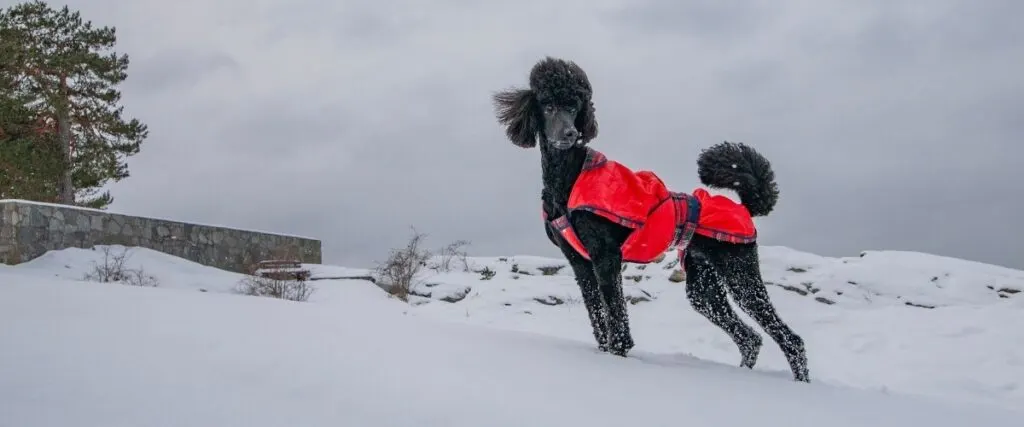As the winter months approach, it’s important to consider your poodle and how well they can tolerate the cold weather.
This article explains what temperatures are safe and unsafe, how long your poodle can be outside in cold weather, tips to keep your poodle safe, and the signs that indicate your poodle is too cold.
Everything you need to know to keep your poodle safe and sound this winter, is below!
Table of Contents
Can Poodles Tolerate Cold Weather?

Poodles generally do not handle cold weather very well, although they may tolerate it for 10-15 minutes at a time. The larger the poodle, the more tolerable they will be. Poodles only have a single-layered coat, which provides little protection against the outside elements.
Although poodles can certainly go out and play in the snow for 10-15 minutes, they generally can’t handle prolonged exposure to cold temperatures.
This is mainly because of their single-layer coat, which provides little insulation and protection against the cold and outside elements.
Does it matter which poodle you have?
Standard poodles can tolerate cold conditions a little better than miniature poodles or toy poodles because of their larger size and greater muscle mass. But still, caution should be taken whichever poodle you have.
- Aside from their build and coat, poodles are not a northern breed, meaning they have no extensive history of surviving in cold climates.
Again, another big reason as to why most don’t handle cold conditions very well.
Trending article: How long can poodles actually be left alone?
What Temperature Is Too Cold For a Poodle?
Ok, so you know that Poodles don’t do very well in cold weather, but how cold is too cold? What temperature is too low for a Poodle?
It’s crucial to consider the weather conditions rather than the temperature. Here’s why…
For example: 5°C (40°F) is fairly cold but perfectly tolerable on a sunny, dry, wind-free day for most poodles. However, if you take the same temperature on a wet, dark, and windy day, it’ll feel dramatically colder and most poodles won’t be able to handle that.
| Temperature vs Conditions | Sunny / dry / no wind | Windy / wet / dark / snowy / |
|---|---|---|
| 10°C / 50°F | Tolerable | Tolerable when exercising. Protection may already be required |
| 5°C / 40°F | Tolerable when exercising | Potty breaks only |
| 0°C / 30°F | Tolerable when exercising. Protection advised | Potty breaks only |
| -5°C / 20°F | Potty breaks only | Potty breaks only & shelter necessary |
Biggest Threats To Poodles in Cold Weather
Poodles, just like other breeds are susceptible to certain cold weather-related issues…
Paw pads
The paws are very sensitive to temperature and can even freeze if exposed to ice and snow for prolonged periods of time.
Frozen pads are prone to split, combine this with toxic ice melt chemicals and grit on the pavements and your Poodle is in for a rough ride! The paws are sensitive and need protecting.
Nose
It’s healthy for your dog’s nose to be wet, but in the winter this causes issues. The issue with wet noses is that the cold wind will quickly dry out the moisture, causing the nose to chap and crack.
The more your poodle licks her nose the more the chapping and cracks continue to get worse until it becomes a painful issue that will require veterinary assistance.
Skin and coat
It’s always the same, winter comes around and you’ve got dry skin, dry lips, dry hair, dry everything! Well, it’s the same for your poodle too! This is because the cold air cannot hold moisture like warm air can and is therefore far less humid than warmer months.
Your poodle’s skin and coat are at risk from drying out too much during the winter months which usually leads to excessive scratching, rashes, and raw skin.
This is original content produced and published by The Puppy Mag: www.thepuppymag.com

Psst. A word on Poodle training! Brain Training For Dogs could be the best training approach we’ve seen for all poodles. Results show improvement in obedience and behavior quicker than we thought possible! It’s absolutely worth checking out.
Other Poodle Articles:
My Poodle Won’t Eat! Here’s Why
Can Poodles Be Left Alone? How Long Is Too Long
How To Potty Train a Poodle in 4 Simple Steps (Quickly)
Cold Weather Protection For Poodles
Let’s run through some of the ways you can protect the vulnerable paws, nose, skin, and coat from the elements. Properly protecting these areas will allow your poodle to remain warmer for longer and the risk of hypothermia will be reduced.
1. Paw Wax or Winter Boots (paw protection)
To protect the paws you have two options. Paw wax or winter boots. Both have their pros and cons so let’s summarize them.
Paw wax: Paw wax may prove to be more comfortable than wearing winter boots and it’s just a matter of rubbing in the wax before you head out. Paw wax will form a barrier protecting against snow, ice, and ice melt chemicals. Paw wax can help keep the paw pads moisturized and healthy. Recommended Option
● The only issue is that paw waxes are all made differently, some are good and some are kinda useless. Low-quality waxes may rub off before your walk has finished leaving the paws exposed and vulnerable.
Winter boots: Winter boots or “booties” are far more durable and reliable than paw wax. Booties can be waterproof which provides excellent protection against the snow, ice, and ice melt chemicals.
They usually have a tough rubber sole for grip, but also doubles up as protection against salt and grit. Winter boots are more expensive than paw wax, but in many people’s opinion, are a better option. Recommended Option
● The only issue with winter boots is getting them to fit correctly. If the material is too tough it may end up rubbing and chafing your Poodles feet.
2. Nose balm or butter (nose protection)
Using nose balm before your Poodle gets a chapped nose is key! So if it’s getting cold where you are, wait no longer before ordering some.
Prevention is always better than cure, but there are still some nose balms out there that double up as a healing cream. So if you are a little too late, nose balm is still an option.
Usually, nose balm is applied once per day, but if it’s to treat existing issues the frequency may be different and you’ll have to refer to the packaging.
Many owners use nose balm throughout the entire year due to its range of benefits. Not only does it keep the nose moisturized and protected from chapping and windburn, but it will also prevent sunburn in the summer.
3. Winter jackets
Winter jackets will act as a double layer of fur, protecting your Poodle from the outside elements. Some jackets are waterproof and these are the most recommended as they will provide the best protection. Kurgo Winter Jacket (Top Recommendation)
Although a jacket will not stop her skin and coat from drying out, it will keep your Poodle significantly warmer while out exercising.
It’s important to get a winter jacket that fits correctly and opt for one that has reflective material. Winter days can be gloomy and the extra visibility will allow you and others to see your Poodle clearly. This is crucial when walking close to roads.
Signs Your Poodle Is Getting Too Cold

Hypothermia and frostbite are serious health emergencies that you must avoid. Thankfully, there are many signs you can look out for which indicate that your Poodle is getting too cold.
Always be quick to act and if you see any of the following, you should head back inside as soon as possible to prevent an emergency.
Shivering or trembling:
If you notice your Poodle has started to shiver and tremble then it’s time to head back indoors.
Shivering is an automatic response whereby the muscles quickly contract and relax in succession to provide heat throughout the body.
Holding up a paw:
One of the most reliable signs that indicate your Poodle is getting too cold is when she starts to hold up a paw off the ground. If you see this, you should head back inside as soon as possible.
If your Poodle is wearing booties, she may not be inclined to hold up a paw, but it doesn’t mean she isn’t cold. Always consider the other following signs.
Slowing movements:
If your Poodle starts slowing down it’s not a good sign. This means shes already cold and you need to head back inside.
Your Poodle may even refuse to walk further which again means the walk is over. In the worst-case scenarios, you’ll need to physically pick her up and walk her back to the car.
Hunch back:
When we are cold we tend to bring our shoulders up to our ears, right? Well, dogs do a similar kind of thing and they hunch their backs. If you see this, cut the walk short and head back home.
Tail in between legs:
This is a general indication of discomfort, anxiety, or stress in dogs and will likely happen when your Poodle becomes too cold.
Unusual behavior:
Any other displays of unusual behavior should also be closely monitored. This includes random barking, whining, or unusual physical movements. If anything seems out of place, head back inside.
Extra Tips & Advice For Cold Weather Conditions
The following tips are a combination of preventative measures as well as general safety tips. All designed to keep your poodle safe throughout winter.
1. Always remove snow and ice build-up from paws
If your Poodle isn’t wearing booties then you will need to physically remove ice and snow build-up from in between the toes.
Keeping on top of this will reduce the chances of the paw pads freezing and will ultimately help keep her body temperature up.
2. Bathe your poodle as usual. But keep her inside and use lukewarm water
You can carry on bathing your Poodle as usual, but it’s absolutely crucial to keep her indoors afterward. It’s important to get her dry as quickly as possible so be sure to use a towel and even the hairdryer (just not on the hottest setting).
Bathing once every couple of months will keep her skin and coat healthy and moisturized. Be sure to use a natural ingredient shampoo AND moisturizer.
Stick to lukewarm water and avoid cold or hot temperatures. The hotter the water the higher the chances of drying out her skin after the bath.
3. Wear an extra layer when you go out
Wearing an extra jumper will serve two great purposes. It will keep you warmer (always a bonus) but more importantly, it will serve as a blanket in case your poodle gets too cold all of a sudden.
If your poodle starts refusing to walk you can wrap her in your jumper, pick her up, and bring her back to the car.
4. Avoid wet or rainy days
Even if the temperature isn’t that low, rain and wet conditions will make your Poodle feel cold. It’s better to be safe than sorry, so for wet conditions, stay inside and exercise your Poodle around the house. This brings me to the next tip.
5. Practice exercising at home
Sometimes the weather is just going to be too bad to leave the house, and that’s ok! There are many ways you can exercise your Poodle at home.
Games such as tug of war, fetch, hide and seek, and chasing will all do a good job of raising the heart rate. If you’re not sure whether it’s too cold or not, play it safe and stay at home!
6. Adjust her diet
It’s normal for dogs to have a greater appetite throughout winter and will naturally burn more energy while keeping warm.
As long as it’s within a healthy weight range, increase your Poodles cup size just a little or give her some additional plain chicken breast throughout the week. This will increase her overall calories and will help her gain a little healthy weight.
Dogs with greater mass are better able to keep warm in cold conditions.
7. Avoid lakes, rivers or bodies of water
Many of you probably walk your Poodle in your local park which may have a small pond or lake. If you do, stay well clear of it.
Whether the water is frozen or not, it’s a huge safety hazard not only for your Poodle but for you too if you find yourself in a rescue situation. Avoid bodies of water at all costs.
8. Ensure she has good recall
It’s a very good idea to start practicing easy recall training games within your home. This will slowly improve her recall for when you are out walking her.
The ability to call your Poodle and have her come right back to you immediately could even be life-saving. A dog who doesn’t come back when called is a bad mix for cold weather.
9. Playing in the snow is fine, but keep it short
Your Poodle will probably love playing in the snow, and that’s fine! But just keep your overall walks short. There’s a fine line between having fun and suddenly getting too cold.
No matter how much fun your Poodle is having in the snow, keep it to 20 minutes or less, and ensure she is constantly moving to avoid losing body heat.
Final Thoughts
Poodles do not tolerate cold weather very well. Whether you have a standard, miniature or toy poodle, the answer remains the same. Poodles only have a single-layered coat which offers little protection against the elements like wind, rain, snow, and ice.
Remember that it’s not about what the mercury level reads, it’s about the conditions and what it feels like. Zero degrees on a sunny dry day with no wind is very different from zero degrees with wind and rain.
Most Recommended For Poodles
Best Brush For Your Poodle
The best brush to keep your poodle tangle-free is without a doubt a simple Slicker Brush. This brush will also do a good job at removing loose hairs and debris from the coat.
Best Online Training Program
Brain Training For Dogs has become increasingly popular in the last few years and is now recognized as one of the best ways to train dogs in the most stress-free, positive way.
Best Low-Calorie Treats
Keep your poodle at the correct weight by switching out the high-calorie treats and opting for something healthier. Zuke’s Mini Naturals contain only 2 calories per treat and are made from natural ingredients, making these some of the healthiest treats on the market.
